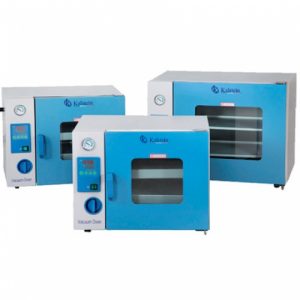The laboratory ovens or drying ovens is equipment used to dry and sterilize glass and metal containers in a laboratory. It is also known as a drying oven. They work between room temperature and 350°C. Usually these equipments are made of stainless steel, both on the outside and inside, this gives them a high durability. In addition, they have a microprocessor that ensures a uniform temperature and allows digital graduation.
What is the specific function of a ovens ?
Drying ovens have two primary functions in a laboratory: Drying and sterilizing the glass and metal material used in laboratory work, in examinations and tests performed in the laboratory.
After being used in any job, the metal and glass implements are washed and then placed in the ovens for drying and sterilization, leaving them ready for later use. The sterilization performed in the ovens is produced by dry heat at 180 ºC for about two hours. This absorbs any traces of moisture and eliminates any persistent biological activity on the surface of these materials.
What are the different types of ovens?
You should note that in the market you can find several types of laboratory ovens:
Natural convection ovens: Extracts air from the environment in which the ovens is located. So it transmits heat in a uniform way throughout the equipment creating a natural air circulation. They have a double chamber. The air enters the bottom of the double chamber, is heated by passing through the combustion chamber and is evenly distributed throughout the room.
Forced convection ovens: In this type of ovens, air is generated inside the machine in a forced manner. This air is at room temperature. They are perfect for routine daily work, providing the ideal heating and drying solution for your applications. Forced or mechanical convection allows for rapid sample drying and heating, higher temperature uniformity, and rapid temperature recovery after the door is opened.
Vacuum oven: They allow products to be dried at very low temperatures, in the absence of oxygen and with the possibility of solvent recovery. These equipment are designed for the gentle drying of heat sensitive samples and usually have adjustable overtemperature protection. They are used in the areas of clinical, hospital and food analysis, for drying materials that are thermosensitive, whose increase in temperature can destroy cells of bacteriological colonies, or materials that oxidize under heating This type of ovens can be static, with the product placed inside trays on hot plates. A vacuum group with a solvent condenser reduces the pressure inside the chamber and allows the solvent to evaporate at very low temperature. Vacuum ovens can also be rotating. In this case the product is loaded into a rotary drum with a heating liner.
Vacuum ovens are suitable for a wide variety of products in the fine chemistry, pharmaceutical chemistry, cosmetics and agri-food industries: extracts of medicinal plants, antibiotics, enzymes, crystalline products, dyes, plastic granules, food additives, spices and seasonings, fruit juices, drying of products requiring a low residual moisture content.
At Kalstein we have an excellent range of laboratory ovens , which we put at your disposal. That’s why we invite you to take a look at the “Products” menu. HERE

